
We are told in Where is Anne Frank’s prologue that writer/director Ari Folman’s parents were sent to Auschwitz the same week as famed diarist Anne Frank. That was part of the inspiration for this animated feature examining her life from the perspective of Kitty, the imaginary friend Anne chose as recipient of her feelings and experiences in her diary. Kitty magically materializes in the Anne Frank House in Amsterdam, innocent of what happened to her dear friend. She must seek out the answers to her whereabouts. In that way, Folman sets up a clever and insightful way of both explaining the Holocaust to young viewers, and considering in what ways we are currently in danger of repeating history.
When Kitty appears in modern day Amsterdam, she has no idea 75 years have gone by. Taking the diary, she embarks on a quest to find Anne, and does so with the help of Peter, a pickpocket and undocumented refugee who has taken responsibility for others in similar circumstances at a secret shelter. She follows the diary through to Anne’s tragic death in the camps. It is with Peter’s support that she then shines a light on the plight of refugee children, inspiring viewers young and old by pointing to their inclusion and acceptance as a mission worthy of Anne Frank’s courage and sacrifice.
The creation and release of this animated feature sprang out of a desire by the Anne Frank Foundation to teach the younger generation about dangerous nationalism and narrow hateful beliefs that led to the Holocaust. They asked Folman to write a script and direct a film which expanded on Anne’s diary, and put it into context of the growing discrimination, bigotry, and anti-semitism happening around the world. The filmmakers certainly achieve their aim in the finished product, as Where is Anne Frank is uniquely suited to both entertain and educate children about a very sensitive subject, without scaring them or scarring them with the sort of imagery one would see in a live action feature. Though the film does confront what happened to Jewish people during the Holocaust, the audience is never shown the violence or death in the camps in any literal way. it does, however, consider the idea of complicity, both then and now. If there are children of war at risk of ethnic cleansing or extermination, shouldn’t countries around the world take note and welcome them to safety? Kitty becomes a bridge between Anne’s time and today, as an activist standing for refugee children fleeing war zones.
To read the Where is Anne Frank? review in its entirety, go to the AWFJ.org site HERE.



